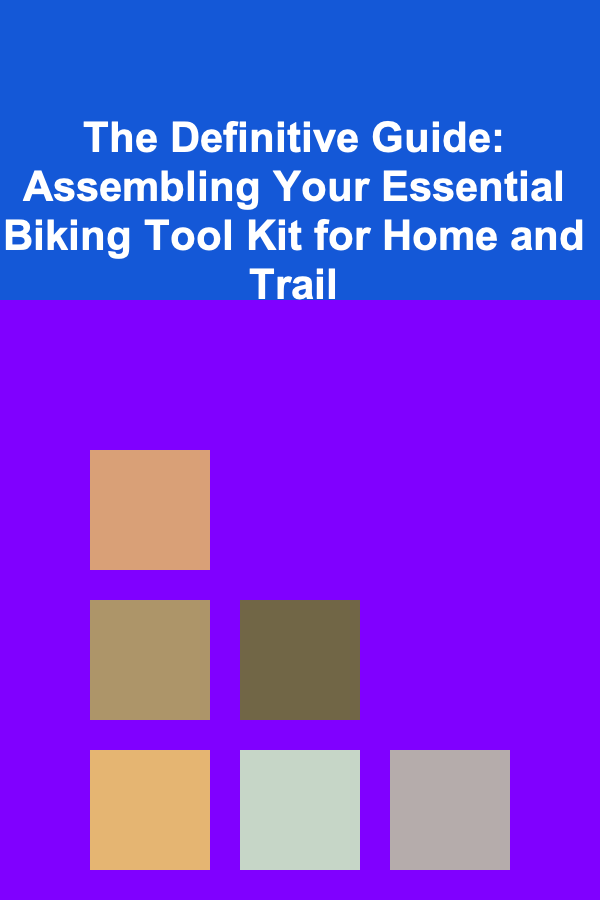
The Definitive Guide: Assembling Your Essential Biking Tool Kit for Home and Trail
ebook include PDF & Audio bundle (Micro Guide)
$12.99$6.99
Limited Time Offer! Order within the next:

Cycling is more than just a sport or a hobby; for many, it's a lifestyle, a mode of transport, and a source of profound enjoyment. However, like any mechanical endeavor, bicycles require maintenance, adjustment, and occasional repair. The ability to diagnose and fix common issues yourself not only saves money but also fosters a deeper connection with your machine and empowers you to ride with confidence, knowing you can handle most situations the road or trail throws at you. This comprehensive guide delves deep into assembling two distinct, yet complementary, biking tool kits: one for the meticulous home mechanic and another for the intrepid trail adventurer.
While the allure of a fully stocked professional workshop is undeniable, the reality for most riders is a gradual accumulation of essential tools. This article aims to demystify the process, providing a structured approach to building a robust toolkit that evolves with your skills and cycling ambitions. We will explore the critical tools for each environment, discuss their specific applications, and offer insights into best practices, ultimately transforming you from a mere rider into a self-sufficient cycling connoisseur.
Part 1: The Home Workshop -- Foundation for Mastery
Your home workshop is the sanctuary where your bike receives the love and attention it deserves. It's where you perform routine maintenance, tackle more complex repairs, and fine-tune your ride for optimal performance. Building a home toolkit is an investment in your cycling future, allowing you to learn, experiment, and save significant money on shop labor over time. The key here is quality, organization, and a gradual accumulation based on need and curiosity.
General Principles for the Home Workshop
- Quality Over Quantity: Resist the urge to buy the cheapest multi-tool set. Good tools last longer, perform better, and are less likely to damage your bike's components. Park Tool, Pedro's, and Var are examples of reputable brands.
- Organization: A pegboard, a dedicated toolbox, or even a simple drawer can keep your tools tidy and easily accessible. A clean, organized workspace fosters efficiency and enjoyment.
- Lighting: Good lighting is paramount for seeing small components and ensuring proper assembly.
- Workspace: A stable workbench or a clear section of your garage/shed is ideal. A repair stand is arguably the most transformative home tool you can buy.
- Safety First: Always wear appropriate personal protective equipment (PPE) like gloves and eye protection when working with chemicals or sharp tools.
Essential Core Tools for the Home Mechanic
These are the foundational tools that will enable you to perform the vast majority of common bike maintenance tasks, from basic adjustments to component swaps.
- Hex/Allen Key Set: The absolute cornerstone of any bike toolkit. Modern bikes predominantly use hex bolts.
- L-shaped keys: Economical, good leverage for tight bolts, available individually or in sets (2mm, 2.5mm, 3mm, 4mm, 5mm, 6mm, 8mm, 10mm are most common). Look for ball-end versions for easier access at angles.
- T-handle keys: Offer better ergonomics and speed for repetitive tasks.
- Y-wrenches: Combine the three most common sizes (typically 4mm, 5mm, 6mm) into one convenient tool.
- Torx Key Set: Increasingly common on higher-end components, disc brakes, and some accessories. T25 is the most frequently encountered size, but a full set (T10, T15, T20, T25, T30) is advisable.
- Screwdrivers:
- Phillips head: For derailleur limit screws, some shifter components, and accessories. Sizes #1 and #2 are most common.
- Flathead: Less common on bikes themselves, but useful for prying, aligning, or older components.
- Pliers:
- Needle-nose pliers: For reaching into tight spaces, manipulating small parts, or pulling out stuck cables.
- Diagonal cutters (wire cutters): Essential for cleanly trimming cable housing, zip ties, and brake/derailleur cables. Do not use for brake or shifter inner cables unless they are specifically designed for that.
- Slip-joint pliers: General purpose, good for gripping various shapes.
- Adjustable Wrench (Crescent Wrench): While specific wrenches are always better, a good quality adjustable wrench can handle various nuts and bolts, especially axle nuts on older bikes or pedals if a dedicated pedal wrench isn't available. Choose one with minimal jaw play.
- Tire Levers: Absolutely essential for removing and installing tires. Get a set of three strong, non-marring levers (plastic or composite are generally preferred over metal to protect rims).
- Floor Pump with Gauge: Critical for maintaining proper tire pressure, which impacts ride quality, efficiency, and puncture resistance. Ensure it has a reliable pressure gauge and compatibility with both Presta and Schrader valves.
- Bicycle Repair Stand: While an investment, a repair stand is a game-changer for home mechanics. It elevates the bike to a comfortable working height, allows the wheels to spin freely, and provides stability, making almost every task easier and more enjoyable.
- Chain Tool (Chain Breaker): Necessary for breaking and installing chains, especially when replacing worn chains or performing drivetrain work. Ensure it's compatible with your chain's speed (e.g., 9-speed, 10-speed, 11-speed).
- Quick Link Pliers (Master Link Pliers): For easily opening and closing quick links (master links) found on many modern chains. These are a massive time and frustration saver.
- Cassette Tool & Chain Whip: Needed to remove and install your rear cassette (the gear cluster on your rear wheel). The chain whip holds the cassette still while the cassette tool (usually a splined socket) unscrews the lockring.
- Bottom Bracket Tools: The specific tool depends on your bottom bracket type (e.g., Hollowtech II external cups, square taper, DUB, press-fit). You'll likely need a large socket wrench or a specific multi-tool for this.
- Pedal Wrench (15mm): A long-handled, thin 15mm wrench designed to provide the necessary leverage for removing stubborn pedals. Some pedals also use 6mm or 8mm hex keys.
- Cone Wrenches (13mm, 15mm, 17mm): Thin, specialized wrenches for adjusting cup-and-cone bearings in older style hubs. Less common with modern cartridge bearing hubs but indispensable if you have them.
- Spoke Wrench: For truing wheels (adjusting spoke tension). Spoke nipples come in various sizes, so a multi-size spoke wrench or specific wrench for your wheel's nipple size is required.
- Cable Cutters: High-quality cable cutters (often called "housing cutters") are essential for making clean cuts on brake and shifter cables and housing, which is critical for smooth shifting and braking performance.
Lubricants, Greases, and Cleaning Supplies
Proper lubrication and cleanliness are as important as the right tools for prolonging component life and ensuring smooth operation.
- Chain Lube: Essential for reducing friction, preventing rust, and prolonging chain life. Choose dry lube for dusty conditions and wet lube for rainy/muddy conditions, or an all-rounder.
- Assembly Grease: For preventing corrosion, reducing friction, and easing future disassembly on threaded components (pedals, seatposts, bottom bracket threads).
- Anti-Seize Compound: Especially important for titanium frames, dissimilar metals (e.g., aluminum seatpost in a steel frame), or any high-stress threaded connection to prevent galling.
- Degreaser: For cleaning greasy drivetrain components. Biodegradable options are preferred.
- Cleaning Brushes: Various sizes for cleaning the drivetrain, frame, and wheels. A dedicated chain cleaning tool can be very effective.
- Rags/Shop Towels: Abundant supply for cleaning, wiping excess lube, and general shop tasks.
- Isopropyl Alcohol: Excellent for cleaning disc brake rotors and pads (never use degreaser or other cleaners on rotors!).
Consumables and Small Spares for the Home
- Inner Tubes: Several spares in the correct size and valve type for your wheels.
- Patch Kits: For minor tube punctures, as a backup to tube replacement.
- Quick Links: One or two spare quick links for your chain speed.
- Brake Pads: Replacement pads for your specific brake type (rim or disc).
- Derailleur and Brake Cables/Housing: A few spares for emergency replacements.
- Zip Ties: In various sizes, incredibly versatile for routing cables, securing accessories, or quick fixes.
- Spare Bolts/Nuts/Washers: Small, commonly lost hardware (e.g., water bottle cage bolts, disc rotor bolts).
- Disposable Gloves: For keeping your hands clean when working with greasy components.
Specialized and Advanced Tools (Gradual Accumulation)
As your skills grow and your bike stable expands, you might consider these more specialized tools:
- Torque Wrench: Absolutely crucial for carbon components and any bolt with a specified torque value. Prevents over-tightening (damage) and under-tightening (safety hazard). Comes in various ranges (low torque for small bolts, higher for cranks/BB).
- Derailleur Hanger Alignment Tool: If you frequently bend derailleur hangers, this tool saves you money on replacements and ensures crisp shifting.
- Bearing Press/Removal Tools: For replacing cartridge bearings in hubs, bottom brackets, or suspension pivots. Specific tools are often needed for different bearing sizes.
- Hydraulic Brake Bleed Kit: If you have hydraulic disc brakes, a bleed kit is essential for maintenance and optimal braking performance. Specific to your brake brand (SRAM, Shimano, Magura, etc.).
- Wheel Truing Stand: For building wheels or perfectly truing existing ones. A significant investment, but invaluable for serious wheel work.
- Headset Press and Remover: For installing and removing headsets (the bearings that allow your fork to steer).
- Crown Race Setter: For properly seating the crown race onto the fork steerer tube.
- Facing Tools: For precisely machining head tubes and bottom brackets to ensure perfectly parallel surfaces. High-end, rarely needed by home mechanics unless building a frame from scratch.
- Chain Wear Indicator: A simple gauge to tell you when your chain is worn out and needs replacement, preventing premature wear on cassette and chainrings.
- Vernier Caliper: For precise measurements of components, bolt lengths, seatpost diameters, etc.
Tip: Start Small, Grow Organically: Don't feel pressured to buy everything at once. Begin with the core essentials, then add specialized tools as specific needs arise. Many repair tasks can be learned via excellent online resources (YouTube tutorials from reputable mechanics like Park Tool, GCN, or your bike brand's channels are invaluable).
Part 2: The Trail Side -- Emergency Preparedness
While your home workshop is for comprehensive care, your trail kit is for survival. Its purpose is singular: to get you and your bike back home or to the nearest point of assistance after an unexpected mechanical setback. Compactness, lightweight design, and multi-functionality are paramount here. Every item should earn its place.
Guiding Principles for the Trail Kit
- Minimalism: Pack only what's absolutely necessary to perform critical, ride-saving repairs.
- Multi-functionality: Tools that can perform several tasks are highly valued (e.g., a multi-tool).
- Weight and Size: Every gram and cubic centimeter counts, especially on long rides or for performance-oriented cycling.
- Accessibility: Tools should be easy to access quickly, often while wearing gloves or in less-than-ideal conditions.
- No Substitutions for Experience: A tool is only useful if you know how to use it. Practice common trailside repairs at home.
The Absolute Essential Trail Kit (No Ride Without These)
This is the bare minimum you should carry on any ride, regardless of distance or terrain.
- Mini-Pump or CO2 Inflator System:
- Mini-Pump: Reliable, always works (no cartridges to run out), but requires more effort. Look for one with a hose to reduce valve stem stress.
- CO2 Inflator: Fast and easy inflation, but limited by cartridge supply. Carry at least two cartridges. Environmentally, less ideal than a pump.
- Spare Inner Tube: Even if you run tubeless, a spare tube is your ultimate insurance against sidewall tears or tubeless sealant failures that can't be plugged. Ensure it matches your wheel size and valve type.
- Tire Levers: Two or three robust plastic tire levers. Metal levers can damage rims.
- Patch Kit: A small kit with glueless patches (for quick fixes) and/or traditional glue-on patches (more durable for larger punctures).
- Multi-Tool: The workhorse of the trail kit. Look for one that includes:
- Hex/Allen keys: (2mm, 2.5mm, 3mm, 4mm, 5mm, 6mm, 8mm).
- Torx bits: (T25 is most common).
- Screwdrivers: Phillips and flathead.
- Chain Breaker: Crucial for repairing a broken chain (which can render your bike unrideable).
- Optional: Spoke wrenches, bottle opener (important for post-ride!).
- Quick Link (Master Link): A spare quick link compatible with your chain's speed. Essential for rejoining a broken chain after using the chain breaker.
- Derailleur Hanger (Spare): If your bike has a replaceable derailleur hanger, carrying a spare can save your ride if you impact it. They are specific to your bike model.
- Tire Boot (or Dollar Bill): For repairing large sidewall cuts in your tire that a patch kit can't handle. A folded dollar bill (or an energy gel wrapper, duct tape) can serve as a temporary boot to get you home.
- Zip Ties: Invaluable for a myriad of temporary fixes: securing loose cables, holding a flapping fender, or even temporary splinting.
- Duct Tape (small roll/wrap): Wrap a few feet around your mini-pump or a pencil. Extremely versatile for repairs from torn shorts to temporarily patching a tire.
- Disposable Gloves: To keep your hands clean during greasy chain repairs.
- Basic First Aid Kit: Small cuts, scrapes, and blisters are common. Include antiseptic wipes, bandages, pain relievers, and any personal medications.
- Identification, Phone, and Emergency Contact Info: Always carry these. A fully charged phone is vital for navigation or calling for help.
- Cash/Credit Card: For emergencies, food, or a cab ride.
Warning: Check Compatibility: Ensure all components in your trail kit (e.g., quick link, inner tube, multi-tool sizes) are compatible with your specific bike and components before you head out.
Advanced Trail Kit (For Longer Rides, Bikepacking, or Remote Areas)
If you're venturing further afield, bikepacking, or riding in truly remote locations, consider adding these items:
- Valve Core Remover: Small tool for removing Presta valve cores, useful for adding tubeless sealant trailside.
- Small Pliers: Needle-nose or small slip-joint pliers can be surprisingly useful for bent brake rotors, removing thorns, or manipulating small parts.
- Chain Lube (small bottle): For multi-day rides, keeping your chain healthy is important.
- Spare Cleats & Bolts: If you ride clipless pedals, losing or breaking a cleat bolt can make riding difficult or impossible.
- Headlamp/Small Light: Even if you don't plan to ride in the dark, unforeseen delays can mean you need light for repairs or navigation.
- GPS Device / Power Bank: For navigation and ensuring your phone doesn't die.
- Water Filter/Purification Tablets: For extended trips where water sources may be unreliable.
- Survival Blanket: For warmth in unexpected cold weather or emergencies.
- Whistle: For signaling for help.
How to Carry Your Trail Kit
Where you store your kit impacts accessibility and comfort. Common methods include:
- Saddle Bag (Seat Pack): Most common, keeps essentials low and out of the way. Sizes vary from minimalist to large bikepacking bags.
- Frame Bag: Fits within the bike's main triangle, good for larger items and better weight distribution.
- Top Tube Bag: Convenient for frequently accessed items like snacks, phone, or a small multi-tool.
- Backpack/Hydration Pack: For carrying more extensive kits, water, extra layers, and food. Distributes weight well but can make your back sweaty.
- Jersey Pockets: For very minimalist setups (tube, CO2, multi-tool), common among road cyclists.
- "Tool Bottle": A plastic water bottle that fits in a bottle cage, repurposed to hold tools.
- Integrated Storage: Some modern mountain bikes have hidden storage compartments in the frame.
Part 3: Beyond the Tools -- Knowledge, Practice, and Maintenance Philosophy
Possessing an impressive array of tools is only half the battle. The other, equally important half, is knowing how to use them, understanding your bike, and embracing a proactive maintenance philosophy.
Cultivating Knowledge and Skill
- Online Resources: YouTube is a goldmine for bike repair tutorials. Channels like Park Tool, Global Cycling Network (GCN), and specific brand channels offer step-by-step guides for almost any repair. Forums and dedicated cycling websites also provide a wealth of information.
- Bike Repair Manuals: Invest in a good bicycle repair manual (e.g., by Zinn & the Art of Road Bike Maintenance or the Park Tool Big Blue Book). These provide detailed diagrams and instructions.
- Local Bike Shops (LBS): Don't be afraid to ask questions. Many shops offer basic maintenance clinics or are happy to explain a repair they've done for you.
- Practice: The best way to learn is by doing. Practice simple tasks like changing a tire, adjusting brakes, or breaking a chain in a low-pressure environment at home. This builds confidence for trailside emergencies.
The Maintenance Mindset
- Pre-Ride Checks: A quick visual and tactile check before every ride can prevent major issues. Check tire pressure, brake function, quick releases, and listen for unusual noises.
- Post-Ride Cleaning: Especially after dirty or wet rides. A clean bike lasts longer and runs smoother. Focus on the drivetrain.
- Periodic Deep Dives: Every few months (or more frequently depending on your riding volume and conditions), perform a more thorough inspection: check bolt torques, inspect chain wear, examine brake pads, and clean/lube pivots.
- Listen to Your Bike: Bikes often "talk" to you through sounds. Squeaks, creaks, grinding, or clunking noises are usually signs that something needs attention. Don't ignore them.
Knowing Your Limits
While self-sufficiency is empowering, there are times when professional help is the wisest course of action:
- Complex Issues: If you're unsure about a repair, don't have the specialized tools, or lack the confidence, it's better to take your bike to a reputable LBS.
- Safety-Critical Components: Issues with brakes, steering, or structural frame damage should always be handled by experienced professionals. Your safety is paramount.
- Warranty Concerns: Some complex repairs, especially on newer bikes, might void your warranty if not performed by an authorized dealer.
- Time vs. Money: Sometimes, the time and frustration saved by letting a professional handle a task outweigh the cost.
Tip: Document Your Bike's Specs: Keep a record of your bike's specific component sizes (e.g., bottom bracket type, headset type, chain speed, spoke lengths if you're serious about wheel building). This makes ordering parts and choosing tools much easier.
Assembling your essential biking tool kit for both home and trail is a journey, not a destination. It's an ongoing process of learning, acquiring, and refining based on your evolving needs and the specific demands of your cycling adventures. The distinction between the comprehensive home workshop and the minimalist trail kit is crucial: one fosters mastery and detailed care, while the other ensures resilience and self-reliance in the face of unexpected challenges.
By investing in quality tools and, more importantly, in your own mechanical knowledge, you unlock a deeper level of enjoyment and freedom in your cycling. You'll spend less time sidelined by minor issues and more time confidently exploring the world on two wheels. Embrace the grease, cherish the learning curve, and ride with the assurance that you are prepared for whatever the path may bring.

How to Build a Checklist for Handling Unexpected Travel Delays
Read More
How to Edit Your Travel Photos for Maximum Impact and Sales
Read More
How to Increase Your Rental Property's Value
Read More
How to Learn from Successful Home Staging Examples
Read More
How to Organize Your Bills to Avoid Late Fees
Read More
How to Systemize Your Operations for Profit
Read MoreOther Products

How to Build a Checklist for Handling Unexpected Travel Delays
Read More
How to Edit Your Travel Photos for Maximum Impact and Sales
Read More
How to Increase Your Rental Property's Value
Read More
How to Learn from Successful Home Staging Examples
Read More
How to Organize Your Bills to Avoid Late Fees
Read More